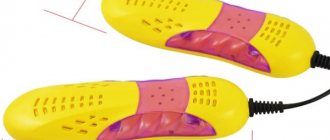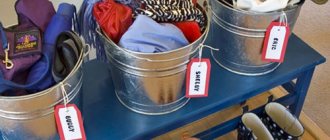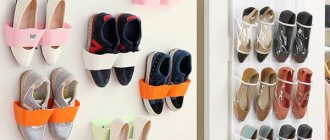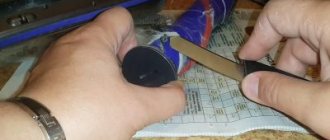Organizing compact shoe storage is not an easy task. The problem is especially pressing in large families and owners of small apartments.
Human imagination is inexhaustible and offers a lot of options for storing out-of-season shoes.
For example, plastic shoe boxes: we’ll look at their pros and cons, types, prices, how to choose and other nuances today.
Storage rules
Proper storage requires compliance with the following rules:
- Always dry your shoes before storing them. Moisture and dampness can quickly render it unusable, sometimes in just a couple of days.
- Shoes should be thoroughly cleaned and repaired if necessary. Old, stubborn stains are much more difficult to remove than fresh ones, and timely repairs will save you from unpleasant surprises when it comes time to take it out of the box.
- The storage area should be dark, dry and well ventilated. Sunlight can cause paint to fade. High humidity leads to mold and mildew.
- The cabinet for storing shoes should be located away from heating devices to avoid them drying out.
- To prevent drying out, cracking and loss of shine, use softening creams, emulsions and other special products according to the material from which the shoes are made.
- Shoes should be stored flat. Bends and creases will lead to delamination and cracks.
- It is unacceptable to dump all the shoes together. This will lead to scratches, burrs and other damage to its surface. Ideally, each couple should have their own box.
Following these simple rules will significantly increase the service life of your shoes and save you from unnecessary expenses.
Useful tips
In order not to be upset about an unsuccessful purchase, it is important to consider some points:
- Since plastic is not a “breathable” material, there must be holes in the box.
- An unpleasant, pungent smell of plastic indicates its poor quality; it is better not to buy it.
- You should not store plastic boxes with shoes on an unheated balcony or loggia; during low temperatures, the containers may crack, and the shoes may become deformed or become moldy.
- You need to choose models that do not taper at the bottom; they are inconvenient for storing shoes and arranging boxes in orderly rows.
- It is better to place colored plastic boxes away from sunlight, as the products will fade under its influence.
Everyday shoe storage
Caring for everyday shoes is most often neglected. At best, they leave it to dry if it suddenly gets wet. Because of this, your favorite boots, shoes and boots quickly become unusable, often long before the end of the season.
At the same time, timely cleaning allows you to get rid of most stains and avoid the need to use aggressive solvents. Dry shoes are less deformed during wear and do not get dirty as much, and treatment with special means protects them from moisture, dust and dirt. Therefore, do not forget to clean, dry and lubricate your shoes after each use, regardless of their price category and time of year.
A place for everyday shoe storage is also important. It is desirable that it is well ventilated and spacious enough. It should stand freely, without the surface touching each other. No moisture should accumulate under the sole.
Traditional storage in the hallway has a lot of inconveniences. As a rule, there is little space there, which means it’s impossible to avoid overcrowding. The only solution is to organize the space as much as possible using drawers and cabinets, and also promptly remove shoes that are not used for seasonal storage.
DIY devices
There are many original ideas for arranging shoe storage. Convenient organizers, massive shoe racks, hanging racks and shelves are made to a certain standard. They are not always suitable in style and size for small dressing rooms or hallways. Homemade devices will last no less, but will add a certain zest to the interior of the room.
Rails and strips for storing shoes
You can organize compact shoe storage from long strips or sections of cornice. The convenient railing system is very popular. It is often used in spacious wardrobes to save space. Anyone can make an original stand with their own hands from scrap materials, based on a detailed description of the work progress.
You can install shoe rails at the bottom of the closet or niche. First, we measure the distance from one wall to the other and cut off two pieces of cornice with a small margin. We mark the location of the holes and drill the recesses. We place homemade roof rails one above the other. In this way, you can make holders for light shoes on the inside of the cabinet door.
PVC pipe rack for shoes
Light plastic can be used to make a beautiful shoe shelf or a large industrial-style rack. For the work you will need the pipes themselves, fittings, corners, and flat boards. First of all, we make a detailed drawing. It is necessary to indicate the specific installation location, the number of crossbars, and design parameters (height, width, depth).
Having prepared and cut the parts to size, you can proceed to assembling the rack. All elements must be assembled according to the previously created diagram. We put plugs on the legs and lean part of the structure against the wall. We make four holes in the wooden boards along the edges with a diameter slightly larger than the pipe. We thread them through, placing them at the required distance from each other. To increase the strength of the rack, the plastic joints can be additionally secured with self-tapping screws. If necessary, the pipes can be cleaned with sandpaper and painted with spray paint.
How to adapt regular hangers for shoes
The simplest coat hanger can be used as an original and practical shoe storage device. In this way, you can place pairs with high tops (boots, ankle boots) in a closet or niche.
The role of a rod can be performed by any rail or even a tight cord. We pass clothespins through the bottom bar of the hanger and pinch the shoes at the top of the boot. One item will fit a pair of boots. The ideal option is trouser hangers with soft bolsters. They will not damage the material and will not leave characteristic jagged creases.
Features of storing leather, patent leather, suede, rubber shoes
There are the following care features depending on the type of material from which it is made:
- patent leather shoes are lubricated with Vaseline or glycerin and wrapped in wrapping paper, spacers are inserted inside;
- leather is treated with a softening cream, rubbing it in with a soft brush, polished with a flannel cloth and stored flat, using wooden blocks, liners, and spacers for this purpose;
- Rubber shoes are wiped with a sponge containing glycerin to prevent them from delaminating;
- Suede is first dried, and only then cleaned, using special brushes for this purpose;
- Sports and fabric shoes are washed in soapy water, if the instructions allow, dried and stored in tight bags with mothballs.
Advice! Do not use mothballs when storing rubber shoes. It makes it rougher and can even change its color.
How to store seasonal shoes
Due to the fact that winter and summer storage takes a long period of time, preparation must be carried out quite carefully:
- Remove the laces and insoles.
- Get rid of accumulated debris inside.
- Treat the inner surface with an alcohol solution.
- Wash the fabric and sole thoroughly.
- Dry completely at room temperature.
- Send for storage.
The main difference in storing winter and summer shoes is that for the winter version you should use naphthalene, which will protect the fur from moths. Tall boots are usually stored in a suspended state, straightened out.
It is worth noting! It is strictly forbidden to keep shoes on the balcony, as temperature fluctuations and high humidity are detrimental to things.
Where to store?
For everyday storage, it is best to allocate a room specially equipped for this - a dressing room with a good ventilation system and shelving. If the area of the apartment does not allow for such luxury, then you can use wardrobes, shoe boxes, and hanging shelves.
To store seasonal shoes, boxes, special containers, organizers, fabric covers, and the like are most often used. The main conditions that must be observed when choosing them:
- presence of holes for ventilation;
- sufficient volume;
- no foreign odor.
Boxes
They are quite convenient and practical. The only drawback is that through them you cannot see what shoes are stored there. The improved model has a viewing window on the side wall.
You can buy such boxes in a specialized online store, or you can make them yourself from cardboard and a piece of transparent polyethylene. The explanatory drawing on the lid will also make it much easier to find the right pair of boots if necessary.
Types of Shoe Boxes
Most often, boxes are made of white or colored plastic. Products can be:
- With hinged lids.
- Fully removable lid.
- Drawers.
- Handles for carrying.
- In the form of a suitcase.
- Assembled from several products.
in size :
- for men's,
- women's shoes,
- boot,
- ankle boots,
- boot.
You should always read the information on the label carefully.
Standard sizes are as follows:
- for men's shoes 34*21*13;
- for women's shoes 30*18*10;
- for boots 52*30*11.5.
Sizes may vary slightly among different manufacturers and models.
In terms of strength, plastic can be thin and dense . The first option will not support more than three to four boxes stacked on top of each other. Dense plastic is able to retain its shape in any design.
Some online stores offer special modules made from boxes stacked on top of each other like a chest of drawers with a pull-out mechanism. There can be a small number of them - 3, 4, 5, or large structures of 6, 9, 12 or more boxes.
Containers
A plastic container for storing shoes has the following number of advantages over a cardboard box:
- strength
- transparency
- original design.
They can no longer be hidden from guests. Bright colors and original appearance will allow them to easily blend into the interior of a modern home.
Organizers
shoe storage organizer The fabric walls allow air to pass freely, which ensures its free circulation, while protecting it from dust.
Disadvantages - it will not protect against spilled tea or other liquid, and it is not worth storing expensive shoes in it, since the soft fabric walls will not protect against mechanical damage and deformation.
How to use?
Before packing boxes for storage, you should pack your shoes properly. If you purchased containers for adult models, then children can come in 2-3 pairs . Slippers, ballet shoes and other flat-soled items can also be stacked in several pairs.
It is better to stack boxes on top of each other, this saves space, so it is better to purchase products made of durable plastic.
There are other options for storing shoe boxes. It can be:
- hallway;
- closet;
- mezzanine;
- niche;
- pantry;
- space under a sofa, bed or stairs;
- wardrobe.
Any secluded room is suitable for storing shoes. The main thing is that there is good air ventilation, darkness and less moisture.
You can put the boxes in a visible place, then it is important to think about the aesthetic component. In this case, one of the main tasks will be not only convenience and compactness, but also beauty. The selected models and colors must correspond to the general idea of the interior.
Shoe storage systems
The shoe storage system is a modern solution to the problem. It is a set of all kinds of shelves, racks, and drawers. All modules are easy to install and, if necessary, supplemented. As an example, you can take IKEA shoe storage systems. They can be produced either as a ready-made solution or made to order, equipped with clothes hangers and mirrors.
Such systems are very convenient to place in small hallways. They allow you to make maximum use of the available space, fitting just a huge number of all kinds of things in a small area.
Advice! Open drawers and shelves will not protect shoes from dust, so it is not advisable to store seasonal shoes on them.
Should summer shoes be put away for winter?
But first, let’s figure out whether it’s necessary to put out-of-season shoes in the back drawer at all? In our opinion, an autumn revision is not necessary only for those who have enough space in their shoe closet and those who often travel to warm countries in the winter. But even in this case, it is worth putting the worn pairs in order (cleaning, changing the heels, etc.), and also removing them from open shelves or hiding them in boxes (since in just a couple of months the shoes will become very dusty).
Tip: If you decide not to put away your summer shoes for the winter, then it is best to organize your shoe storage according to the principle: tall, heavy and dark pairs at the bottom (most of the demi-season and winter shoes will be here), and light and light ones at the top (summer shoes will be here) ). In this case, you should group pairs into categories, for example: “sneakers and sneakers”, “ballet flats and loafers”, “boots”, etc. You will see that with this arrangement the shoe closet will become comfortable and neat in appearance.
Closet
Storing shoes in a closet is an excellent solution for small apartments. A retractable door saves space, and closed shelves reliably hide shoes from prying eyes.
Such a wardrobe can be placed in the corner of the room, built into the gap between the bed and the wall. Made to order, it will fit perfectly into the interior of the apartment and help solve the problem of storing shoes in the best possible way.
Wall structures
A non-standard solution - wall structures made of metal rods. The heel is hooked onto them and the shoes are stored in this way. Such structures can be placed anywhere - in a wall niche, in the spaces between furniture, on the inside of the closet door.
You can simply hang all your shoes in pockets-bags on the wall, and so that they do not confuse the eye, decorate them with a curtain or a sliding curtain.











